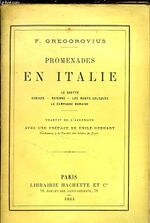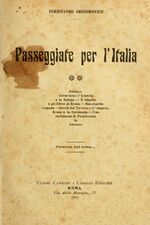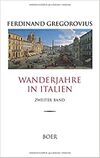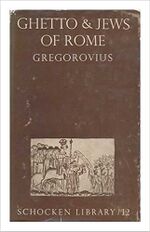Difference between revisions of "File:1856 Gregorovius.jpg"
Tag: Manual revert |
|||
| (10 intermediate revisions by the same user not shown) | |||
| Line 1: | Line 1: | ||
[[File:1894 Gregorovius fr.jpg|thumb|150px|French ed. (1894)]] | [[File:1894 Gregorovius fr.jpg|thumb|150px|French ed. (1894)]] | ||
{de} [[Ferdinand Gregorovius]] <1821-1891>. '''''Der Ghetto und die Juden in Rom'''''. In ''Wanderjahre in Italien: Figuren, Geschichte, leben und Szenerie aus Italien''. | {de} [[Ferdinand Gregorovius]] <1821-1891>. '''''Der Ghetto und die Juden in Rom''''' (1856). In ''Wanderjahre in Italien: Figuren, Geschichte, leben und Szenerie aus Italien''. Leipzig [Germany]: Leipzig: F.A. Brockhaus, 1856. | ||
== Other German editions == | == Other German editions == | ||
[[File:1935 Gregorovius de.jpg|thumb|left|150px|1935 ed.]] | |||
[[File:1907 Gregorovius it.jpg|thumb|150px|Italian ed. (1907)]][[File:2021 Gregorovius de.jpg|thumb|left|100px|2020 ed.]] | |||
[[File:1948 Gregorovius en.jpg|thumb|150px|English ed. (1948)]] | |||
* ''Der Ghetto und die Juden in Rom'', ed. [[Leo Baeck]]. Berlin [Germany]: Schocken, 1935. | * ''Der Ghetto und die Juden in Rom'', ed. [[Leo Baeck]]. Berlin [Germany]: Schocken, 1935. | ||
| Line 18: | Line 19: | ||
* {en} ''The Ghetto and the Jews of Rome'', ed. [[Moses Hadas]]. New York: Schocken Books, 1948 <1853>. | * {en} ''The Ghetto and the Jews of Rome'', ed. [[Moses Hadas]]. New York: Schocken Books, 1948 <1853>. | ||
== Abstract == | == Abstract == | ||
| Line 24: | Line 24: | ||
"A century ago the great German historian Ferdinand Gregorovius settled in Rome to work on his epochal study of postclassical Rome. There he came to know the miserable little community of Jews that had lived in the eternal city without interruption for two millenniums ... For clarity and conciseness this essay is a classic ... The prose account summarizes the varying intensity of the hardships perennially endured by the Jews in Rome ... Segregation, the yellow badge, exclusion from trades, and compulsory attendance at conversionist sermons were only finally abolished by Pious IX in 1848 ... The author's poetic "Lament of the Children of Israel in Rome" discloses his capacity for empathy and his deep pity and admiration for the people he came to know in the days of their emancipation."-- Review by J. Coert Rylaarsdam, The Journal of Religion 26.4 (Oct. 1949). | "A century ago the great German historian Ferdinand Gregorovius settled in Rome to work on his epochal study of postclassical Rome. There he came to know the miserable little community of Jews that had lived in the eternal city without interruption for two millenniums ... For clarity and conciseness this essay is a classic ... The prose account summarizes the varying intensity of the hardships perennially endured by the Jews in Rome ... Segregation, the yellow badge, exclusion from trades, and compulsory attendance at conversionist sermons were only finally abolished by Pious IX in 1848 ... The author's poetic "Lament of the Children of Israel in Rome" discloses his capacity for empathy and his deep pity and admiration for the people he came to know in the days of their emancipation."-- Review by J. Coert Rylaarsdam, The Journal of Religion 26.4 (Oct. 1949). | ||
"Die Ausgabe ist eine vollständige. Sie enthält die Aufsätze aus den fünf Bänden der »Wanderjahre in Italien« mit Ausnahme derjenigen, die nur rein zeitgeschichtlichen Wert haben. Fortgelassen sind daher: »Toskanische Melodien«, »Die römischen Poeten der Gegenwart«, der Italien nicht berührende Aufsatz »Avignon«, »Die sizilianischen Volkslieder«, »Neapel und Sizilien von 1830 bis 1852« und »Der Krieg der Freischaren um Rom«. Sie haben mit den »Wanderjahren« an sich nichts zu tun, sind teils Buchbesprechungen, teils Aufsätze über Zeitereignisse, die Gregorovius damals nur aufnahm, weil er zum erstenmal eine Sammlung seiner Aufsätze herausgab. An ihrer Stelle hat der Herausgeber die in den Rahmen der »Wanderjahre« fallenden Aufsätze über »Die öffentlichen Monumente in Florenz«, »Die Villa Malta in Rom«, »Das Bourbonenschloß Caserta« und »Segesta, Selinunt und der Mons Eryx« aufgenommen. Er fühlte sich dazu um so eher berechtigt, als Gregorovius selbst in den verschiedenen Auflagen der »Wanderjahre« Änderungen in der Zusammensetzung vorgenommen hatte. Eingefügt wurden auch die auf seinen Wanderungen und unter dem unmittelbaren Eindruck des Geschauten entstandenen Gedichte. So enthält diese Ausgabe in der Tat den gesamten literarischen Niederschlag der italienischen Wanderjahre und gibt uns ein geschlossenes Bild des »Wanderers« Gregorovius als Mensch, als Künstler, als Gelehrter. Auch hier dürfte Ferdinand Gregorovius selbst seine Zustimmung gegeben haben."--Publisher description (2021). | |||
| Line 31: | Line 32: | ||
[[Category:Rome, Jews (subject)]] | [[Category:Rome, Jews (subject)]] | ||
[[Category:Ghetto, Italy (subject)]] | [[Category:Ghetto, Italy (subject)]] | ||
[[Category:Gregorovius, Ferdinand (1821-1891)]] | |||
Latest revision as of 15:56, 6 March 2022
{de} Ferdinand Gregorovius <1821-1891>. Der Ghetto und die Juden in Rom (1856). In Wanderjahre in Italien: Figuren, Geschichte, leben und Szenerie aus Italien. Leipzig [Germany]: Leipzig: F.A. Brockhaus, 1856.
Other German editions
- Der Ghetto und die Juden in Rom, ed. Leo Baeck. Berlin [Germany]: Schocken, 1935.
- Der Ghetto und die Juden in Rom: Klagegesang der Kinder Juda in Rom. Bremerhaven [Germany]: Kniess, 1986.
Translations
- {fr} Le ghetto. In Promenades en Italie. Préface de Émile Gebhart. Paris [France]: Librairie Hachette, 1894 <1853>
- {it} Il ghetto e gli ebrei di Roma. In Passeggiate per l'Italia. Vol.2: [Roma e Lazio], tr. Mario Corsi. Roma: Ulisse Carboni, 1907 <1853>.
- {en} The Ghetto and the Jews of Rome, ed. Moses Hadas. New York: Schocken Books, 1948 <1853>.
Abstract
"A century ago the great German historian Ferdinand Gregorovius settled in Rome to work on his epochal study of postclassical Rome. There he came to know the miserable little community of Jews that had lived in the eternal city without interruption for two millenniums ... For clarity and conciseness this essay is a classic ... The prose account summarizes the varying intensity of the hardships perennially endured by the Jews in Rome ... Segregation, the yellow badge, exclusion from trades, and compulsory attendance at conversionist sermons were only finally abolished by Pious IX in 1848 ... The author's poetic "Lament of the Children of Israel in Rome" discloses his capacity for empathy and his deep pity and admiration for the people he came to know in the days of their emancipation."-- Review by J. Coert Rylaarsdam, The Journal of Religion 26.4 (Oct. 1949).
"Die Ausgabe ist eine vollständige. Sie enthält die Aufsätze aus den fünf Bänden der »Wanderjahre in Italien« mit Ausnahme derjenigen, die nur rein zeitgeschichtlichen Wert haben. Fortgelassen sind daher: »Toskanische Melodien«, »Die römischen Poeten der Gegenwart«, der Italien nicht berührende Aufsatz »Avignon«, »Die sizilianischen Volkslieder«, »Neapel und Sizilien von 1830 bis 1852« und »Der Krieg der Freischaren um Rom«. Sie haben mit den »Wanderjahren« an sich nichts zu tun, sind teils Buchbesprechungen, teils Aufsätze über Zeitereignisse, die Gregorovius damals nur aufnahm, weil er zum erstenmal eine Sammlung seiner Aufsätze herausgab. An ihrer Stelle hat der Herausgeber die in den Rahmen der »Wanderjahre« fallenden Aufsätze über »Die öffentlichen Monumente in Florenz«, »Die Villa Malta in Rom«, »Das Bourbonenschloß Caserta« und »Segesta, Selinunt und der Mons Eryx« aufgenommen. Er fühlte sich dazu um so eher berechtigt, als Gregorovius selbst in den verschiedenen Auflagen der »Wanderjahre« Änderungen in der Zusammensetzung vorgenommen hatte. Eingefügt wurden auch die auf seinen Wanderungen und unter dem unmittelbaren Eindruck des Geschauten entstandenen Gedichte. So enthält diese Ausgabe in der Tat den gesamten literarischen Niederschlag der italienischen Wanderjahre und gibt uns ein geschlossenes Bild des »Wanderers« Gregorovius als Mensch, als Künstler, als Gelehrter. Auch hier dürfte Ferdinand Gregorovius selbst seine Zustimmung gegeben haben."--Publisher description (2021).
File history
Click on a date/time to view the file as it appeared at that time.
| Date/Time | Thumbnail | Dimensions | User | Comment | |
|---|---|---|---|---|---|
| current | 15:03, 5 March 2022 |  | 510 × 800 (53 KB) | Gabriele Boccaccini (talk | contribs) |
You cannot overwrite this file.
File usage
The following 4 pages use this file:




